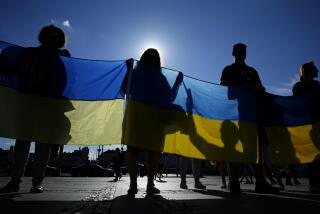Is Soviet Restraint Showing in Managua?
- Share via
Only days before President Reagan announced his new Central American peace plan, Nicaraguan Defense Minister Humberto Ortega said that the Sandinista government intended to purchase Soviet MIG-21 jet fighters. Secretary of State George P. Shultz properly responded that the Sandinistas “will regret it if they do.”
Reports that the Soviets would supply Nicaragua with jet fighters have surfaced periodically since 1984. The jets didn’t materialize before, and they are unlikely to materialize now--even if the war with the contras continues unabated.
The Soviet Union and Cuba, of course, have poured military equipment into Nicaragua--including helicopters, armored vehicles and all kinds of small arms. Moscow would no doubt love to have a Cuba-type base in Central America. Putting MIG-21s into Nicaragua could be a first step.
The United States, however, long ago drew a line in the dirt and warned that the acquisition of advanced jet fighters would be unacceptable. Loosely translated, this means that we might feel compelled to take them out by force.
Maybe the day will come when the Soviets won’t take such warnings seriously because of a perceived U.S. lack of resolve. It is very unlikely, however, that the Soviets are prepared to risk a major confrontation now in a region that has never been high on their list of priorities. Such a move would be especially out of synch with Soviet policy as it appears to be evolving under Mikhail S. Gorbachev.
Since Gorbachev came to power in 1985, many Western observers have noted a seeming deemphasis of confrontational policies in the Third World.
Analyst Francis Fukuyama of the RAND Corp., in a recent study for the Air Force, points out that the shift toward less involvement began even earlier.
At the end of World War II the Soviet military was primarily a conventional land force oriented toward the European theater. The navy was basically a coastal defense force, with little capability for the projection of Soviet power and influence into far-off places.
The Soviets used Third World communist powers as instruments of anti-Western subversion and agitation. They became increasingly involved in the Middle East. But on the whole the Third World did not stand high on Moscow’s list of priorities.
This began to change in the 1960s, with the emergence of competition with China for influence in the Third World, the new opportunities created by Fidel Castro’s delivery of Cuba into the Soviet Bloc and the seeming vulnerability of the Western powers to Soviet-supported “wars of liberation” generally.
The interventionist spirit peaked in the 1970s. Soviet military aid to the Third World increased dramatically.
Soviet military advisers showed up in Angola, Ethiopia and various points in the Middle East. Cuban troops were used as surrogates in Africa. The Soviets developed a deep-water navy capable of projecting Soviet power and presence far beyond Soviet borders.
As early as 1971, then-Foreign Minister Andrei A. Gromyko boasted that “there is not a single question of any importance that . . . can be solved without the Soviet Union or against its will.” Party leaders began suggesting that detente had been imposed on Washington by a tilt of the global power balance in Moscow’s favor.
Second thoughts became evident in the early 1980s. The correlation of forces no longer looked so favorable. The invasion and occupation of Afghanistan in 1979 had not gone well. Pro-Soviet governments in Angola, Mozambique, Nicaragua and Cambodia were beset by internal resistance movements.
Several of Moscow’s best friends in the Third World turned out to be economic basket cases that threatened to become a serious drain on Soviet resources at the very time that the Soviet economy was running out of gas.
When Yuri Andropov took over the Kremlin leadership, he expressed disillusionment with some of Moscow’s so-called “socialist” dependents.
After Gorbachev’s ascension to power in 1985, Moscow openly downgraded Third World priorities by warning that “socialist-oriented” countries must develop their economies “mainly through their own efforts.”
Meanwhile, the Soviet military refocused its attention on its European and Asian borders; talk about the armed forces’ “liberating mission” wasn’t heard much anymore. There are even signs that Gorbachev would like to pull out of Afghanistan--but only if the survival in Kabul of a pro-Soviet government could be ensured.
None of this means that under Gorbachev the Soviets are prepared to abandon the Third World to the West.
The Kremlin has launched an ambitious diplomatic effort to expand Soviet influence in the Pacific region. Military assistance to Third World clients continues--in the case of Nicaragua, the inflow in fact reached record levels in the first half of 1987.
What’s new is an overall posture of restraint, a determination not to let Third World entanglements drain away resources needed for revitalization of the Soviet economy, nor to needlessly create costly confrontations with the West.
Gorbachev obviously wants to expand Soviet contacts in Latin America--especially with important trading countries like Argentina, Mexico and Brazil. That goal would not be advanced by adventuresome behavior in Central America. When Mexican Foreign Minister Bernardo Sepulveda visited Moscow in May, Gorbachev volunteered that the Soviets are not trying to stir up revolution in Latin America.
Just how the prospects for peace in Central America might be affected by all this is unclear. But it’s worth noting that Soviet Bloc oil subsidies to Nicaragua have been reduced.
And Izvestia, the official voice of the Soviet government, recently published a remarkably downbeat portrayal of Nicaragua as a country beset by disastrous economic mismanagement. The contras were described as having succeeded in penetrating most areas of the country.
All in all, Gorbachev & Co. don’t sound like folks who are cranking up to deliver MIG-21s to the Sandinistas.
More to Read
Sign up for Essential California
The most important California stories and recommendations in your inbox every morning.
You may occasionally receive promotional content from the Los Angeles Times.













